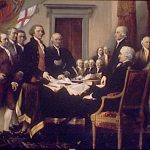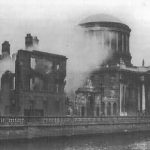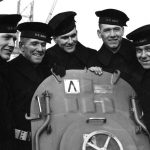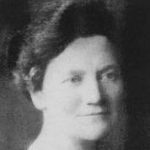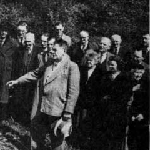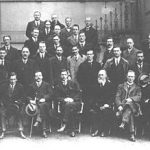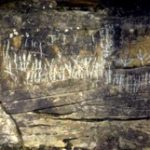Seventy-five years ago, 35 orphans perished in a blaze in St. Joseph’s Orphanage in County Cavan. The orphanage was founded by the Poor Clares, a cloistered order of nuns, on Main Street in 1868. At the time, young delinquents could be educated and learn a trade in a reformatory, but orphaned and abandoned children were not accorded the same opportunity. The good sisters sought to address this by establishing an industrial school for girls. In the early morning of February 24, 1943, a small fire started in the laundry of the old building. Within 45 minutes it gutted the entire school, … [Read more...] about WHEN MORALITY WAS DEADLY
THE STRUGGLE BEGINS ANEW
The traditional role of women in Celtic culture was one of equality in the Brehon Law. The coming of British law changed that and the subordination of women to the nursery and the kitchen began. But, there were always strong Irish women beneath it all. Those who knew the true value of Irish women never doubted their ability and the Ban naTigh (woman of the house) was a valued influence even though shuttered out of official society. The group of Irish scholars who emerged in the mid-1800s from the Gaelic Revival, translated literature from ancient Irish history and inspired a revival of … [Read more...] about THE STRUGGLE BEGINS ANEW
BORN ON CHRISTMAS – REMEMBERED ON NEW YEARS
During the 1904 St. Louis World Fair, John Philip Sousa and his band dominated the entertainment, which included a young John McCormack singing at the Irish Pavilion. It was an era when America’s musical superstars were not individuals with a hit recording, but band leaders – people with the ability to not just play, but compose, arrange, and direct a musical organization. In early America, the superstars were those who led marching Brass Bands, and though Sousa was certainly one of them, he was not the first. That honor goes to a man whom Sousa himself called his mentor and whom he … [Read more...] about BORN ON CHRISTMAS – REMEMBERED ON NEW YEARS
A SPY REVEALED
Thanks to brother Liam Murphy for sharing additional information on a man we had mentioned as one of Washington’s Irish back in July of 2009 on the New York State Website NYAOH.COM and allowing us to share it with you. The 25th of November, 1783, was the last day of America’s War of Independence. After more than seven years of occupation, the British finally evacuated New York City and General Washington, leading members of the Continental Army, entered the city in triumph. To celebrate the event, Brigadier-General George Clinton, New York’s first and longest-serving Governor and a man of … [Read more...] about A SPY REVEALED
THE BATTLE OF MOYRY PASS
On October 2, 1600 a major confrontation took place in Ireland that revealed to the English that the Irish were no longer to be taken for granted as military opponents. Though Anglo Normans controlled the south of Ireland, the major clans of the north remained unconquered and Elizabeth was determined to resolve that issue. The English captured Enniskillen, Hugh Maguire's fort at the Gap of the North - one of two main entries to Ulster. Hugh O'Donnell, Chieftain of Tyrconnell, answered his call for aid, and the two Hughs swept across Ulster driving the English before them; they broke through … [Read more...] about THE BATTLE OF MOYRY PASS
SAD SEPTEMBER AND A SONG
by Mike McCormack, National Historian One of Ireland’s most enduring songs was first published in 1843 in the Young Irelander newspaper, The Nation, under the title Clan Connaill War Song. Its words tell of a prolonged struggle which started in 1594, and is recognized today as the last stand that Ireland made as a nation under her own laws. Led by Red Hugh O’Donnell, in alliance with the great Ulster Chieftains Hugh O’Neill, and Hugh Maguire, the struggle became the Nine Years War, and their opponent was none other that Queen Elizabeth I. The O’Donnells were clan chieftains of Tyr Connaill … [Read more...] about SAD SEPTEMBER AND A SONG
NAPPER TANDY
The name Napper Tandy is one that rolls easily off the tongue; it has a certain ring to it. It is remembered by many for its use in the song, 'The Wearing Of The Green' where we sing: 'I met with Napper Tandy, and he took me by the hand, And he said 'How's poor old Ireland, and how does she stand, 'Tis the most distressful country for it's plainly to be seen, They are hanging men and women for the Wearing of the Green.' I dare say most know nothing further about the man behind this lyrical name. However, he was one of Ireland’s most dedicated patriots and he died on August 24, 1803, … [Read more...] about NAPPER TANDY
CHARLES THOMSON
The name of Charles Thomson is not as familiar today as it was in the early days of America when it was widely known and respected. Born in County Derry, Thomson was one of the most influential men of the entire American Revolution. He served as Secretary of the Continental Congress for over 15 years (the entire life of that body) and was, in fact, the Chief Executive of the American Government several times between 1776 and 1789. During brief illnesses of the Congress Presidents and after John Hancock's resignation from the post in 1786, Thomson served as President, the highest office in the … [Read more...] about CHARLES THOMSON
CIVIL WAR COMES TO IRELAND IN JUNE
Sinn Féin won 73 out of the 105 Irish seats in Parliament in the post-war General Election in December, 1918. They refused to sit at Westminster and instead set up their own government called Dail Eireann on 21 January 1919. On that same day the War of Independence began. After almost three years of brutal warfare, with British atrocities on a civilian population that they felt supported the Dail, the British were beaten to the bargaining table and a treaty was signed. The treaty created the Irish Free State, a self-governing Dominion of the Empire; it was approved by the Dáil 64 to 57 on 7 … [Read more...] about CIVIL WAR COMES TO IRELAND IN JUNE
SAINT COLMCILLE
by Mike McCormack, AOH National Historian On 12 May, 563, Saint Colmcille established a monastery on the island of Iona. Thirty-four years later he died on 9 June 597, which is his universal feast day. In that short time, he exceeded the herculean task that he had set for himself of bringing 3,000 souls to Christ. The story of how and why this all came about is a remarkable one and one that is fully explained in the Major Degrees of our Order. However, without revealing the lesson imparted in that major event, we can entice those who have yet to take that final step toward full membership … [Read more...] about SAINT COLMCILLE
A TALE OF TWO O’HARES
Here are two stories and both are absolutely true – and worth reading! The first began on 5 September 1893 when a son was born in St. Louis, MO to Irish-American parents Patrick Joseph and Cecilia Malloy O'Hare. Then named him Edward and he grew up to be a successful lawyer. He married Selma Louth who gave him three children: Edward (1914), Patricia (1919) and Marilyn (1924). In 1927, Edward moved to Chicago in hope of finding a better life. At the time, Al Capone virtually owned the city and was involved in everything from bootleg booze to prostitution. Capone needed a good lawyer and Eddie … [Read more...] about A TALE OF TWO O’HARES
Irish American Heritage Month: The Fighting Sullivan Brothers
DID YOU KNOW that in the annals of America's heroes, there is scarcely a brighter entry than that of the fighting Sullivan brothers? Born in Waterloo, Iowa to Railroad conductor Tom Sullivan and his wife Alleta, George, Francis, Albert, Joseph, and Madison grew up the best of friends in the closeness of an Irish family and matured into patriotic Americans. It was no surprise therefore, that when Pearl Harbor was attacked, the Sullivan brothers headed straight for the nearest U.S. Navy recruiting office. Navy policy discouraged family members from serving together, but the Sullivans were … [Read more...] about Irish American Heritage Month: The Fighting Sullivan Brothers
Irish American Heritage Month: Ther Angel of Andersonville
DID YOU KNOW that an Irish Catholic Priest Rev. Thomas O’Reilly threatened General Sherman with a mutiny by the Irish Catholics in his army if he torched the church district of Atlanta at the start of his infamous march to the sea and that General Sherman backed down and the entire church district was saved, including the City Hall which stood therein? However, Rev. Peter Whelan was just as courageous in another way. Rev. Whelan distinguished himself as a chaplain for the Montgomery Guards, an Irish company established in Savannah for the First Georgia Volunteer Regiment named for America’s … [Read more...] about Irish American Heritage Month: Ther Angel of Andersonville
Mary MacSwiney
On March 27, 1872, Mary MacSwiney (Maire Nic Shuibhne) was born in Surrey, England, of an Irish father and an English mother. She grew up in Cork beset by illness which culminated with the loss of an infected foot. Educated as a teacher, by 1900 she was teaching in a convent school. Her mother's death in 1904 led to her return to Cork to head the household and secure a teaching post back at St Angela's. The MacSwiney household was intensely separatist. They read Arthur Griffith newspaper, although they rejected his dual monarchy policy. She refused to join Griffith's Sinn Féin because she … [Read more...] about Mary MacSwiney
Irish American Heritage Month: The Irish Contribution to America's Independance
DID YOU KNOW that when America was born, the Irish were there? The Irish, both Protestant and Catholic, were a major part of Washington’s volunteers from foot soldiers to high ranking officers. When increased Crown exploitation drove the colonists to protest, among the loudest were the Irish who had no great love for the Crown to begin with. And there were many Irish in America’s colonies. Among them were those who fought the English theft of their Irish lands and ended up hunted men; they were followed by those Catholics and Presbyterians who fled persecution by the Church of England. Some … [Read more...] about Irish American Heritage Month: The Irish Contribution to America's Independance
THE BOB AND MOLLIE MONTEITH STORY (part I)
Robert ‘Bob’ Monteith was the third son of four with five sisters born March 1, 1879 in Newtownmountkennedy, Co. Wicklow to Joseph (Cavan) and Mary Dillon (Wicklow) Monteith. He was baptized in the Episcopal Church in the diocese of Glendalough. At 16, he joined the British army claiming to be 18. After seeing action in India and Africa, he was honorably discharged on 21 March 1903. Back in Ireland, he secured a job in the Civil Service at an Ordinance Depot in Dundalk, Co. Louth. On weekends would cycle to Dublin to see his parents and siblings. One weekend, they took in a theater … [Read more...] about THE BOB AND MOLLIE MONTEITH STORY (part I)
ONE WAR ENDS – ANOTHER BEGINS
The end of WWI on 11 November, 1918 was followed by a general election in December. Ireland at the time was still suffering from post-1916 animosity and restrictions by the British government. The death of one of the many interned Volunteers, Richard Coleman, on 9 December was alleged by Sinn Féin to be indicative of the mistreatment of prisoners. Coleman’s funeral procession through Dublin bought that Republican party valuable support in the coming election. Of the 105 Parliamentary seats contested in Ireland, Sinn Fein won 73, Unionists won 26 and the Irish Parliamentary Party (IPP) … [Read more...] about ONE WAR ENDS – ANOTHER BEGINS
AMERICA'S FIRST CHRISTMAS CARDS
In 1982, archeologist Dr. Robert Pyle investigated a petroglyph, or rock carving, in Wyoming County, West Virginia. Many such carvings exist whose origins are shrouded in mystery, but Pyle thought this one unique for the carving looked like early runic writing. He lychen-dated it as having been carved between 500 and 700 AD. He recorded every detail of the carving in 18 separate visits, and gave the story to a local newspaper. A reader clipped the article and sent it to the West Virginia Chamber of Commerce which published it in their periodical: Wonderful West Virginia. A copy of the … [Read more...] about AMERICA'S FIRST CHRISTMAS CARDS
CHRISTMAS IN IRELAND
The Christmas season in Ireland is a happy combination of modern and ancient customs that combine to bring a unique meaning to this special time of year. While Christmas shopping, decorated trees, and Santa Claus are evident everywhere, traditional customs that signify the true meaning of this holy season still remain in small towns and villages where some people still celebrate the holy feast as their ancestors had for generations. On Christmas Eve, the windows are decorated with garlands of holly and ivy with candles centered in each -- often in a hollowed-out turnip for support. The … [Read more...] about CHRISTMAS IN IRELAND
GEORGE WASHINGTON’S CHRISTMAS IRISH
There were a few Irishmen living in and around Trenton, NJ prior to the Revolutionary War. Among them were Paddy Colvin and Sam McConkey, who ran two Delaware River ferries; Paddy Lamb, who resided near Quaker Bridge on Assunpink Creek; and John Honeyman, a retired British soldier, now a butcher and cattle-dealer in nearby Griggstown. They were all there during a very special Christmas adventure. Toward the end of 1776, George Washington’s patriot army retreated from New York through New Jersey, headed for the Delaware River with the British army in hot pursuit. On December 1, he sent … [Read more...] about GEORGE WASHINGTON’S CHRISTMAS IRISH







